
New Photos
October 28, 2006
| Snakes |
|
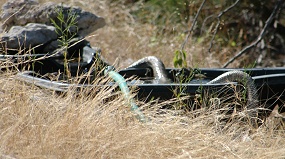 |
|
| One afternoon last year, I was photographing birds at Fox Pavilion when I noticed a light brown hose, as well as a green hose, entering the water. The green hose attaches to one of the rainwater storage tanks, but the brown one? It took me several seconds to realize that the brown hose could not be a hose...but was a snake, drinking. In this picture, the snake is moving away from the camera, draping itself in the water as it goes. I tried to get closer, but Western Coachwhips, Masticophis flagellum testaceous, are alert and wary--and very fast. They're also one of our longer snakes, often topping five feet in length. | |
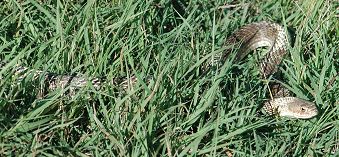 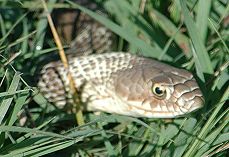 |
|
| Here's another view of a western coachwhip, this time near the north fencerow in the west grass. This one shows a patchy tan/cream effect. Richard rescued a big western coachwhip that had tangled itself in some building materials. We see them rarely, nearly always in the thick pasture grass or in brushy edges near it. They retreat into brush, if they have a chance, and are good climbers...but hunt mainly on the ground. | |
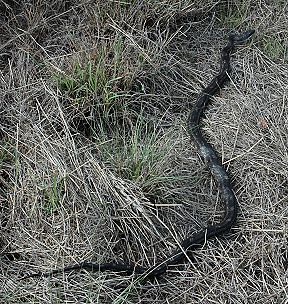 |
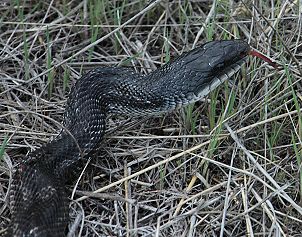 |
| Another of our big long snakes is this black one...I think it's an Eastern Yellowbelly Racer, Coluber constrictor flaviventris. On a chilly spring day, it was stretched out in the sun and let me get close enough to zoom in on its head. | |
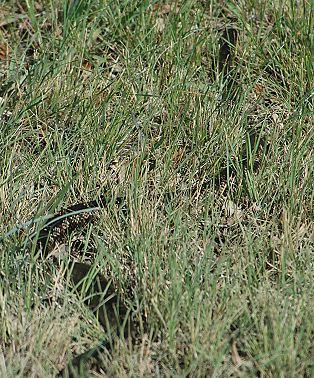 |
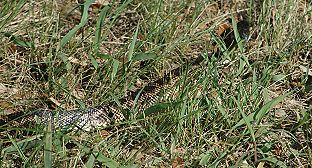 |
| The Texas Rat Snake, Elaphe obsoleta lindheimeri is also a big snake, and handsomely patterned in black (or charcoal brown) and tan (or golden tan, as in this individual) with a black head (usually.) These snakes climb readily, and hunt birds in their nests as well as mammals on the ground. Rat snakes are thicker for their length than coachwhips or racers. Like the other larger snakes, they can be startling to meet suddenly on a path. | |
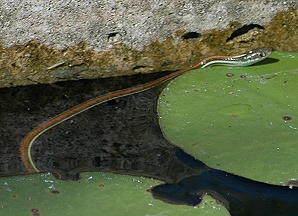 |
|
| Any pond with natural vegetation and frogs will harbor one or more species of small water snake. We're lucky enough to have the prettiest of the little swimmers, the Red-lined Ribbon Snake, Thamnophis proximus rubrilineatus, in our water garden. The frogs would not agree on the luck part, as these snakes feed on tadpoles and small frogs (and this may explain why we had cricket frogs in the pond for only a year...) These snakes are very shy, and swim rapidly into the thickest cover as we walk up to the pond, so photographing them is a challenge. | |
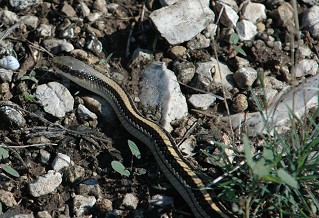 |
|
| Another handsomely striped small snake is the Texas Patch-nosed Snake, Salvadora grahamiae lineata, though its stripes are not as brightly colored. This one lives in Cactus Flat, and was headed back to its burrow on the morning I spotted it. Or possibly someone else's burrow, as these snakes eat lizards, smaller snakes, and reptile eggs. | |
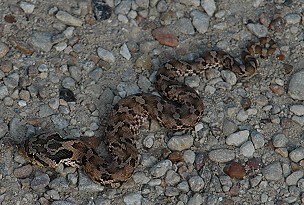 |
|
| Hognose snakes puff up their heads and necks when frightened and manage to look like something else entirely...if you don't notice the tail, they can look a little like rattlesnakes. This Eastern Hognose is a young one, barely longer than hatching length. They're not common around here, as they prefer sandy soil. | |
| We have other snakes on the place, of course, including the Western Diamondback Rattlesnake, the Prairie Ringneck Snake, both Blotched and Diamondback Watersnakes (when there's water in the creek)...but these and others haven't offered themselves as photographic models. We probably have several species we haven't yet seen. All these snakes are predators, feeding on insects, reptiles, amphibians, birds and mammals...and a healthy and varied snake population indicates a wide variety of prey. | |
![]()

